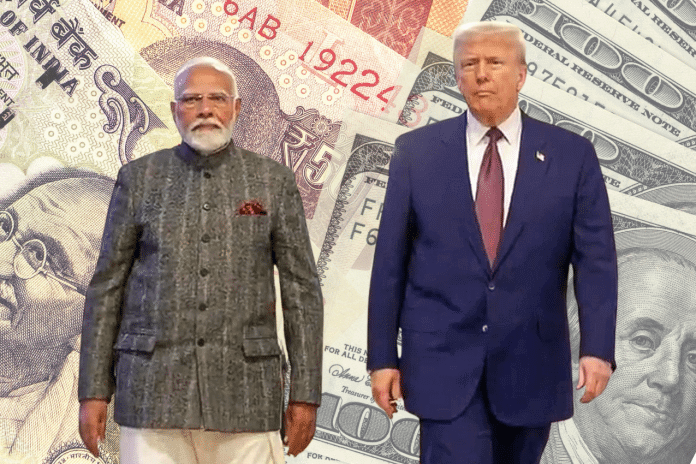Tariffs, economics and GDP may appear abstract concepts. The fundamental concerns of consumers in Australia, India, and the US, however, are similar: stable jobs and affordable prices.
Let’s insert a new abstract term: prisoner’s dilemma. In the context of trade, this happens when two nations have a choice: to mutually lower or raise tariffs, or for one to lower them but not the other. If they have higher but reciprocal tariffs, they can still trade, but will keep looking for other partners. If they have unbalanced tariffs, that is not sustainable. The best scenario is for all players to operate with minimal restraint on trade for both goods and services (visas).
After WWII, nations such as India benefited from their use of tariffs to recover from centuries of exploitation. America had tariffs as low as 0-3% but enforced strict regulations. It also restricted visas, especially against non-white countries. Nevertheless, India’s service sector grew to over USD 1.4 trillion, which would make it a G20 country on its own! zero tariffs
Ideally, goods would move with minimal tariffs, and qualified professionals would cross borders with controlled ease. If not, the consequences are unpleasant. Research from Emkay Global suggests a short-term bearish perspective. A 10% tariff could reduce India’s GDP by approximately $6 billion—only 0.16%. Although somewhat insulated due to its lower dependency on the U.S. market, key sectors like electronics, gems, jewelry, auto parts, and pharmaceuticals remain vulnerable. U.S. imports of Indian electronics amounted to roughly $11.1 billion in a single fiscal year, so even a 9% tariff could strain this market. The gems industry is even more delicate, with nearly 30% of India’s exports in this category—valued at $9.9 billion—destined for the U.S. market, where new tariffs could upset a finely balanced trade relationship. Additionally, a 25% tariff on auto parts, representing an industry valued at $2.1 billion, will hurt India. Similarly, pharmaceutical exports could lose out. None of this would be catastrophic for a 3.5 trillion economy but it will result in tensions.
Going back to the prisoners and their dilemmas on how best to get out of this morass, if both countries enhance their friendly relationship, they mutually benefit—the United States could achieve a 1.5% increase in GDP, while India could experience a 2% boost due to enhanced trade and reduced costs.
However, if the US raises its current average 3% rate to “reciprocate” against India’s own 9.5% tariffs, both parties would lose. (Yes, that is it—not the headline-grabbing 100% tariffs of Harleys and bourbons—unless you have them together). zero tariffs
So, simple prediction: that ain’t happenin’. Instead, they will sign a bilateral trade agreement.
However, an extended prisoner’s dilemma involves multiple players, much like the world. Trump’s tariffs have already reshaped the global trade landscape. Between 2018 and 2019, the United States imposed tariffs on thousands of products and $380 billion in goods. Few people realized that it also raised its own inflation rate, while causing deflation in China. Other countries were not involved so that situation stagnated.
Projections show that tariffs will adversely impact the US—resulting in a 0.4% GDP decline and 309,000 jobs lost. In the long run, domestic manufacturing could strengthen but the benefits will go disproportionately to the manufacturers, rather than consumers at large.
A further escalation poses a significant risk. The problem? Resolving the issues may take months or years, but inflation occurs almost immediately! This phenomenon was evident when U.S. inflation surged from less than 3% since the early ‘90’s to 6% in 2021, following the initial tariffs imposed on China. If repeated, this could erode Trump’s popularity, potentially influencing the Virginia governor’s race in November 2025 and the national mid-term elections in 2026. If Trump loses his major in the House of Representatives, it will be game over for his agenda. Current signs are not looking good for Trump, where the elections on April 1 showed a 10% swing in Wisconsin and Democrats won, and about 15% wing in Florida.
To recoup, Trump must quickly seal agreements with partners like Mexico, Japan, South Korea, UK and India. He must move against China and encourage the relocation of manufacturing. China is also strengthening ties with Japan, South Korea, and India so this competition will help all parties to reduce barriers! That multi-polar prisoner’s dilemma where cooperation is monitored, and defection is fatal is why “reciprocal tariffs” will ultimately help free trade! zero tariffs
If Trump can execute to plan, he has a high probability of success. India can best navigate its challenges not by just acceding to Trump’s demands but by negotiating for more favorable visa policies for Indian professionals. By swiftly transitioning from reciprocal tariffs to zero tariffs, all nations can maximize the benefits of free trade and stimulate sustained economic growth.
READ MORE: Ceasefire or capitulation? Ukraine, history, and the Trump-Putin phone call





